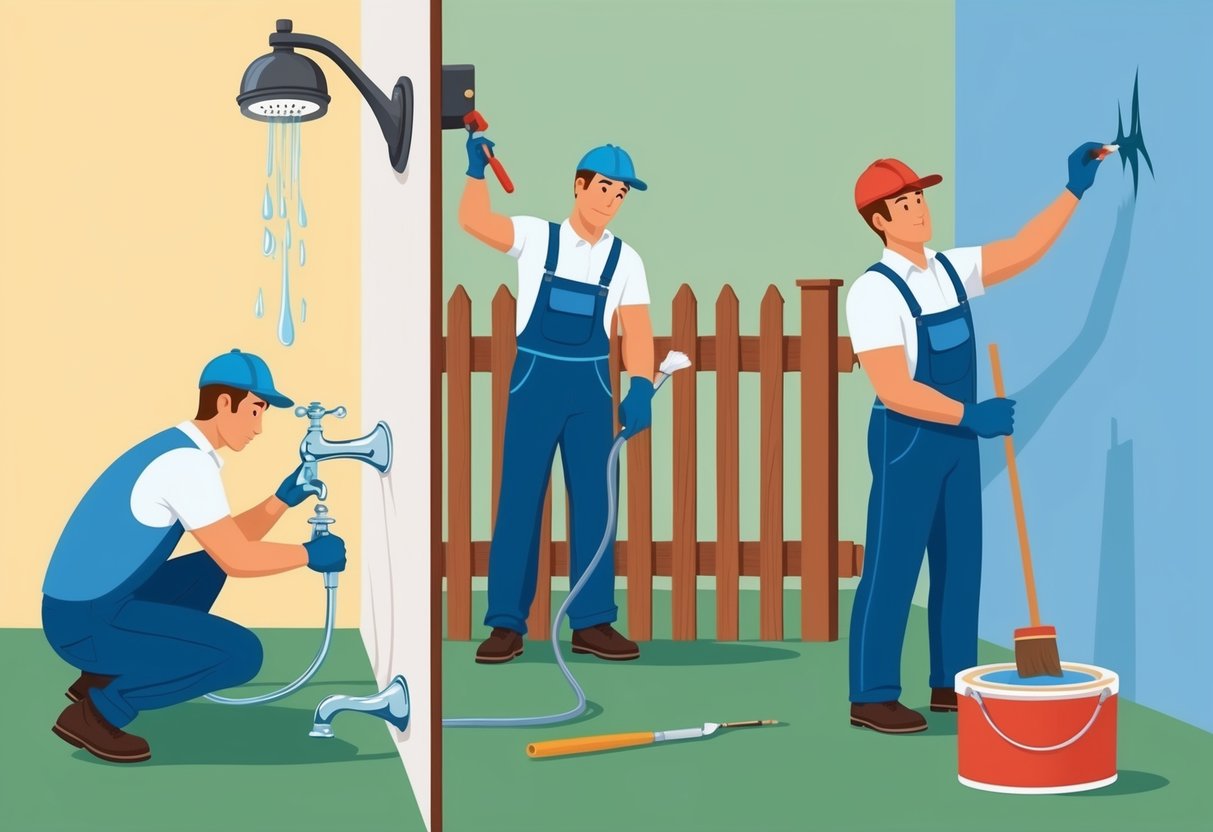
Every homeowner, whether new or experienced, benefits from knowing how to handle basic home repairs and essential maintenance tasks. Having the ability to perform key DIY home repairs—such as patching drywall, fixing leaks, or unclogging drains—saves time, money, and helps prevent small issues from becoming major problems.
Developing confidence with tools and learning core repair techniques not only improves the safety and comfort of a home but also builds valuable long-term skills.
Understanding the top tasks every homeowner should master means being prepared for unexpected issues, from broken switches to leaky faucets. These practical DIY repairs empower property owners to take care of their homes efficiently and avoid unnecessary repair costs.
By learning simple fixes—like applying caulk, resetting tripped breakers, and cleaning or replacing vent filters—anyone can maintain their living space more effectively.
Essential DIY Home Maintenance Skills
Mastering essential DIY home maintenance skills saves money, prevents costly damage, and increases household safety. Key tasks include understanding how to approach basic repairs, implementing safety practices, and following a routine schedule for seasonal home upkeep.
Understanding Basic Home Repairs
Every homeowner should have a fundamental grasp of household repairs and maintenance. Knowing how to repair drywall, change HVAC filters, fix a leaky faucet, and unclog drains helps avoid expensive service calls.
Tasks like caulking, patching small holes, and tightening loose fixtures require basic tools—a hammer, screwdriver set, adjustable wrench, and pliers. Identifying the location of important shutoffs, such as the water main and circuit breaker, ensures quick action in emergencies.
Performing minor electrical work, like flipping breaker switches, is critical for troubleshooting power issues. Understanding basic home repair skills allows homeowners to respond confidently to common problems.
Safety Precautions for DIY Projects
Safety is crucial in any DIY home maintenance project. Homeowners should always read instructions for tools and materials, wear protective gear (gloves, goggles, masks), and work in well-ventilated spaces when handling chemicals or paint.
It is important to ensure that power to circuits or appliances is off before starting electrical repairs. Using a sturdy ladder, avoiding standing water when working with electricity, and keeping workspaces clean significantly reduce the risk of accidents.
For repairs that involve gas lines, turning off the gas supply and double-checking connections is critical. Keeping a well-stocked first aid kit and a fire extinguisher within reach is also essential for any home DIY task.
Seasonal Maintenance Checklist
A seasonal home maintenance routine extends a property’s lifespan and prevents small issues from becoming major repairs. In the spring, tasks include cleaning gutters, checking the roof for damage, testing sump pumps, and inspecting windows for leaks.
Summer maintenance involves servicing air conditioning and maintaining lawns. Fall is an ideal time for sealing cracks, changing furnace filters, and checking insulation.
Winter tasks should focus on preventing frozen pipes, testing smoke detectors, and removing snow from critical pathways. Homeowners can find more details in this seasonal maintenance checklist to keep their property safe and efficient year-round.
Must-Have Basic Tools for DIY Repairs
Every homeowner needs a selection of reliable tools to handle common repair tasks quickly and with confidence. Essential tools such as a hammer, screwdrivers, wrenches, a tape measure, and a utility knife are the foundation for most basic repairs, enhancing safety and efficiency around the house.
Selecting the Right Hammer
A high-quality hammer is a staple in any basic tool kit. The most versatile option for most DIYers is a 16-ounce claw hammer.
It combines enough weight to drive nails without causing excessive fatigue, and the curved claw is ideal for pulling nails and minor demolition. When choosing a hammer, consider the material of the handle.
Fiberglass handles absorb shock well, reducing hand strain, while wooden handles offer comfort and easy grip but may not last as long under heavy use. Steel-handled hammers offer maximum durability but tend to transmit more vibration.
The balance and feel of the hammer are critical. Homeowners should test several options and select one that feels comfortable in hand.
Proper technique matters as much as tool selection for avoiding strain and improving precision. For more information on choosing a hammer and other hand tools, see this guide to essential homeowner tools.
Using Screwdrivers and Wrenches
A screwdriver set is crucial for handling a wide variety of repair jobs. Homeowners need both flat-head and Phillips screwdrivers in several sizes for tasks like tightening cabinet hinges, replacing outlet covers, or assembling furniture.
Look for screwdrivers with magnetic tips for easier handling of screws. Wrenches are essential for plumbing, bike repairs, and securing nuts and bolts.
An adjustable wrench is the most versatile choice and can handle a wide range of bolt sizes. For more complex needs, consider a set of combination wrenches or allen wrenches for specialty tasks.
Pliers, while not always grouped with wrenches, complement these tools and offer grip for loosening or tightening stubborn hardware. Opt for non-slip grips for comfort and safety during extended use.
A comparison of essential screwdriver sets and wrench options can help you understand what best matches your needs.
Measuring Accurately: Tape Measure Tips
A sturdy, reliable tape measure is crucial for precise cutting, installing shelves, or checking the fit of furniture and appliances. A 25-foot retractable tape measure is ideal for most homes, offering enough length for larger spaces without being unwieldy.
Accuracy is improved using the hook at the end of the tape measure to grip surfaces. Ensure the tape remains straight and taut to avoid sagging, which can produce inaccurate readings.
Many tape measures feature both metric and imperial markings, allowing for greater flexibility.
Tips for effective tape measuring:
- Use your thumb to hold the tape in place.
- Read measurements at eye level.
- Retract the tape slowly to prevent spring damage.
For further info on choosing and using tape measures, see the best tools for homeowners.